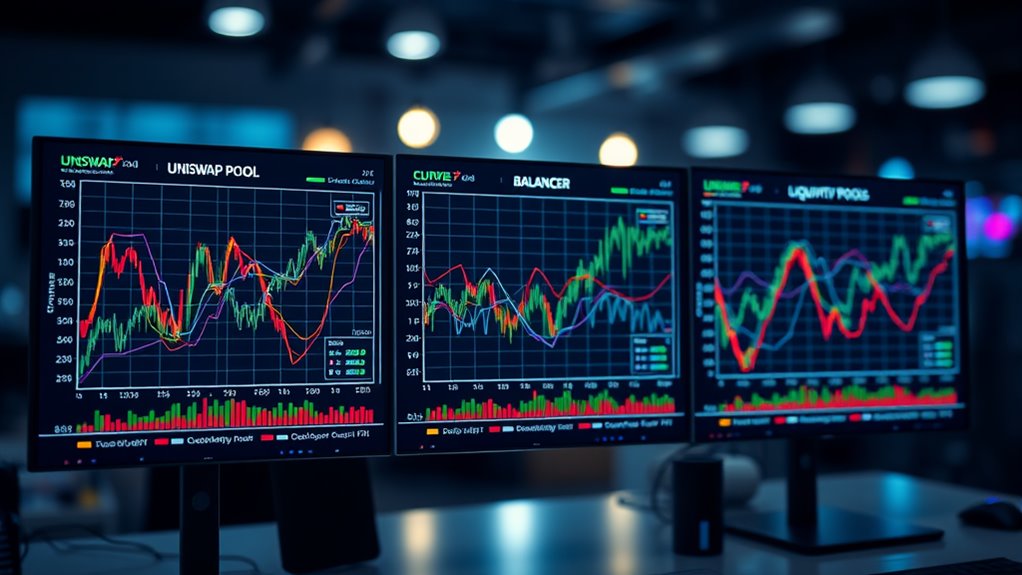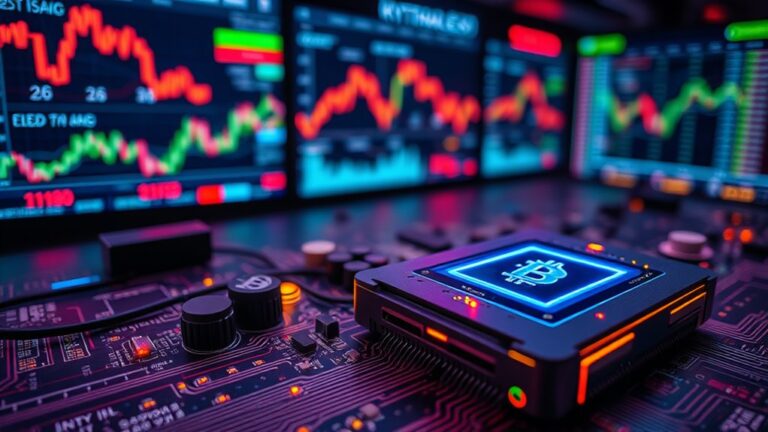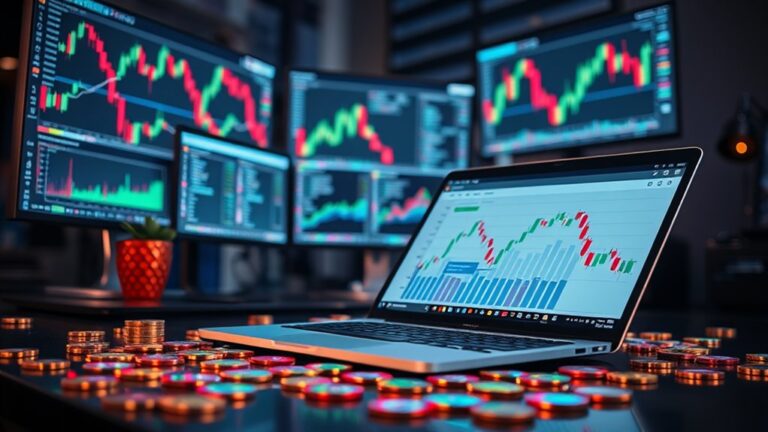
Automated Market Makers (AMMs): How Do They Work?
Automated Market Makers (AMMs) are blockchain-based protocols that enable decentralized trading without order books. They use liquidity pools where users deposit token pairs into smart contracts, creating reserves for trading. Prices are determined algorithmically through mathematical formulas like the constant product equation (x * y = k). These systems operate 24/7, allowing anyone to trade or become liquidity providers who earn fees from transactions. Understanding the different AMM models reveals their unique approaches to handling various asset types.
Key Takeaways
Automated Market Makers (AMMs): How Do They Work?
- AMMs use liquidity pools instead of order books, where users trade directly against token reserves locked in smart contracts.
- Prices are determined algorithmically using formulas like the constant product (x * y = k), enabling 24/7 trading without intermediaries.
- Liquidity providers deposit token pairs and receive LP tokens representing their pool share and entitlement to trading fees.
- Different AMM protocols use specialized formulas: Uniswap employs constant product, Curve optimizes for stablecoins, and Balancer supports weighted multi-asset pools.
- Trades execute automatically through smart contracts, with larger trades causing more significant price impacts due to the mathematical formulas used.
Understanding the Core Mechanism of AMMs in DeFi

While traditional exchanges rely on order books to match buyers and sellers, Automated Market Makers (AMMs) revolutionize trading by using liquidity pools as their foundation. These pools consist of token pairs deposited by users who become liquidity providers. Rather than waiting for counterparties to match orders, trades execute directly against these pools, creating a continuous trading environment.
The system operates without centralized intermediaries, allowing anyone to participate in the market. Liquidity providers earn fees from transactions that occur within their pools, creating an incentive structure that maintains market liquidity. This mechanism guarantees assets remain tradable even in volatile conditions or less active markets.
AMMs align perfectly with DeFi’s core principles by enabling permissionless trading, removing gatekeepers, and creating an accessible financial infrastructure that operates transparently on blockchain networks. Additionally, the use of smart contracts ensures that transactions are automated and executed reliably, enhancing the overall efficiency of the trading process.
The Mathematical Formulas Behind Popular AMM Models

The Constant Product Formula, expressed as x * y = k, forms the mathematical foundation for many Automated Market Makers, including Uniswap, requiring that the product of two token quantities remains constant.
This formula automatically adjusts token prices based on their relative quantities in the pool, with larger trades causing more significant price impacts due to the hyperbolic curve relationship.
Balancer extends this concept with weighted pools that utilize the Constant Mean Formula, allowing multiple assets with different weights, which gives liquidity providers more flexibility in creating customized pools with varying risk-return profiles.
Constant Product Formula
Mathematical elegance underlies the constant product formula, which serves as the foundation for many prominent automated market makers in decentralized finance. This formula, expressed as x × y = k, maintains a constant product between the quantities of two assets in a liquidity pool.
| Feature | Description | Impact |
|---|---|---|
| Formula | x × y = k | Creates hyperbolic price curve |
| Mechanism | Product remains constant | Allows seamless trading without counterparties |
| Price Impact | Increases as liquidity decreases | Larger trades face higher slippage |
When users trade against these pools, the formula automatically adjusts asset quantities while maintaining the constant k. This creates a hyperbolic curve that determines available liquidity at different price points. As one asset’s quantity approaches zero, its price approaches infinity, ensuring continuous liquidity while protecting pools from being drained completely. The efficiency of AMMs enhances financial inclusivity, making decentralized finance more accessible to underserved populations.
Balancer’s Weighted Pools
Building upon the constant product formula, Balancer’s weighted pools represent an evolution in AMM design that offers greater flexibility and customization options. Unlike traditional AMMs that maintain equal token weights, Balancer allows creators to establish pools with customizable weight ratios and up to eight different assets.
The mathematical foundation extends beyond the simple x*y=k formula through a value function that maintains constant values across transactions while honoring designated weight ratios. This approach enables more sophisticated portfolio strategies and can reduce impermanent loss compared to equally-weighted pools.
Spot prices within these pools are determined by token balances and weights rather than external market prices. The system automatically rebalances through trading activity, maintaining desired asset proportions without intermediaries.
For liquidity providers, the model creates new income opportunities through transaction fees while enabling greater diversification. Additionally, the rise of decentralized finance has further amplified the appeal and utility of AMMs like Balancer in the evolving financial landscape.
Liquidity Pools: The Backbone of Decentralized Trading

At the heart of modern decentralized exchanges, liquidity pools serve as the fundamental infrastructure that enables peer-to-peer trading without traditional intermediaries.
These pools consist of paired cryptocurrencies locked in smart contracts, creating reservoirs of assets that traders can access at any time.
When users deposit assets into these pools, they receive LP tokens representing their share of the pool. In return for providing liquidity, these participants earn a portion of trading fees generated by the pool.
The assets’ prices are determined algorithmically, most commonly using Uniswap’s constant product formula (x * y = k), which automatically adjusts based on supply and demand.
This mechanism enables 24/7 trading without requiring matched buyers and sellers, democratizing market participation while supporting DeFi innovation. Additionally, liquidity pools contribute to continuous liquidity that benefits both traders and projects in the decentralized finance ecosystem.
Impermanent Loss and Other Risks for Liquidity Providers

Despite the attractive yields and fee-earning potential of liquidity provision, many participants in AMM protocols face a significant hidden risk known as impermanent loss. This phenomenon occurs when the price ratio of assets in a pool changes, potentially reducing the value compared to simply holding those assets. The loss becomes permanent when liquidity is withdrawn from the pool.
Liquidity providers must navigate the hidden danger of impermanent loss, where changing asset ratios can erode potential profits.
Key risk factors for liquidity providers include:
- High volatility increases impermanent loss exposure
- Different AMM algorithms (like Uniswap’s constant-product formula) impact risk levels
- Trading fees may or may not fully compensate for losses
- Stablecoin pairs generally present lower impermanent loss risk
- New or unmaintained protocols may introduce additional technical vulnerabilities
Mitigation strategies include diversification across multiple pools, monitoring market conditions, and using platforms that offer impermanent loss insurance. Additionally, calculating impermanent loss can be done using specific formulas that consider price ratios at deposit and withdrawal.
Comparing AMM Architectures: Uniswap vs. Curve vs. Balancer

The three major AMM protocols differ fundamentally in their algorithmic foundations, with Uniswap employing a constant product formula, Curve using its StableSwap equation, and Balancer implementing weighted pools.
These mathematical differences directly impact trading efficiency, with Uniswap offering versatility across diverse asset pairs, Curve optimizing for minimal slippage between similar-valued tokens, and Balancer enabling customizable multi-asset compositions.
Each protocol has developed specialized pool mechanisms that serve distinct market needs—Uniswap’s concentrated liquidity for efficient capital deployment, Curve’s stablecoin-focused pools for low-slippage trades, and Balancer’s weighted reserves for complex portfolio strategies.
Algorithmic Design Differences
Decentralized exchanges operate on fundamentally different mathematical principles, creating distinct advantages and limitations for each platform.
These algorithmic foundations determine how assets are priced, traded, and managed within each protocol.
- Uniswap employs a constant product formula (x × y = k) that maintains the same product of reserves during all trades.
- Curve Finance modifies this formula specifically for stablecoins, greatly reducing slippage and fees.
- Balancer introduces weighted pools allowing for customizable asset proportions beyond the 50/50 split.
- Uniswap v3 innovates with concentrated liquidity in specific price ranges, improving capital efficiency.
- Curve’s specialized design enables “tripools” and “metapools” that enhance liquidity between similar assets.
These mathematical differences directly impact trading experience, capital efficiency, and suitability for different asset types within each AMM ecosystem. Furthermore, the integration of DeFi lending practices allows users to leverage their assets for enhanced trading strategies and potential returns.
Specialized Pool Mechanisms
At their core, specialized pool mechanisms represent the fundamental architectural differences that distinguish various automated market makers in the decentralized finance ecosystem.
Each platform offers unique approaches to liquidity provision and trading.
Uniswap pioneered the AMM model with its constant product formula, later evolving to allow customized liquidity ranges in v3, greatly enhancing capital efficiency.
Curve focuses on stablecoin trading through its StableSwap formula, creating environments with minimal slippage through tripools and metapools.
Balancer introduces weighted pools supporting up to eight assets in customizable ratios, functioning similarly to index funds while generating income through fees.
These mechanisms reflect different priorities: Uniswap emphasizes flexibility and efficiency, Curve specializes in stable asset trading, and Balancer offers greater customization for complex portfolio strategies. Additionally, the year 2025 is expected to see increased interoperability among DeFi projects, further enhancing user accessibility and experience.
Arbitrage Opportunities and Price Efficiency in AMMs

When market prices diverge between automated market makers (AMMs) and external exchanges, arbitrage opportunities emerge for traders seeking risk-free profits. These price inefficiencies allow arbitrageurs to buy assets at lower prices in one market and sell them at higher prices in another, helping align AMM prices with global market rates.
- Arbitrage profitability depends on price disparities exceeding transaction costs and fees.
- Blockchain limitations like discrete block times constrain how quickly arbitrage can occur.
- Higher liquidity depth in pools can reduce slippage but also decreases arbitrage profits.
- Continuous fees create “no-trade bands” where small price differences aren’t profitable to exploit.
- Market volatility increases the frequency and size of arbitrage opportunities.
This continuous arbitrage activity benefits the ecosystem by maintaining price efficiency, though it presents risks to liquidity providers through adverse selection, where informed traders extract value from pools.
The Evolution of AMM Technology and Future Innovations

While arbitrage traders maintain price efficiency across markets, the technological foundation that enables these trading mechanisms has undergone significant evolution since its inception.
AMM technology emerged in the late 2010s, with Uniswap pioneering the constant product market maker model in 2018. These early systems focused on creating decentralized liquidity pools that operate continuously without intermediaries.
Today’s AMMs are advancing rapidly, with developers addressing key challenges through layer 2 scaling solutions to reduce transaction costs. New algorithmic models aim to minimize impermanent loss and slippage issues that affect liquidity providers.
The future points toward hybrid systems that integrate with traditional finance and enhanced governance structures. As technological improvements continue, AMMs are expected to play an increasingly crucial role in democratizing access to financial markets globally.
Frequently Asked Questions
How Do AMMS Handle High-Frequency Trading Compared to Centralized Exchanges?
Unlike centralized exchanges built for HFT with dedicated infrastructure, AMMs handle trading through algorithmic pools that prioritize consistent liquidity over speed, limiting high-frequency trading activities while maintaining market stability through mathematical formulas.
Can AMMS Be Vulnerable to Front-Running Attacks?
Yes, AMMs are vulnerable to front-running attacks. Attackers can observe pending transactions in the mempool, then execute their own transactions with higher gas fees to profit from anticipated price movements of the original transaction.
How Do Gas Fees Impact AMM Trading Profitability?
Gas fees reduce trading profitability by adding transaction costs that must be overcome before trades become profitable. They create minimum profitability thresholds, disproportionately affect smaller trades, and establish no-trade zones around price equilibriums for arbitrageurs.
Do AMMS Require KYC Verification for Users?
Presently, most AMMs do not require KYC verification for users. Their decentralized nature allows anonymous trading through smart contracts, though regulatory pressures may potentially push some platforms toward implementing identity verification measures in the future.
How Do Economic Downturns Affect AMM Liquidity and Stability?
Economic downturns typically reduce AMM liquidity as providers withdraw funds due to volatility fears. Price discrepancies increase impermanent loss risk, while reduced trading volumes and capital inflows further compromise AMM stability and efficiency.
Conclusion
While AMMs promised to democratize finance through algorithmic trading, they ironically reproduce many traditional market challenges—impermanent loss, liquidity fragmentation, and arbitrage exploitation—in new digital forms. As DeFi evolves, these mathematical engines of decentralized exchange continue their paradoxical journey: revolutionary in design yet constrained by economic fundamentals that have governed markets since long before blockchain was conceived.












